Posts by Alyson Shane
Case Study: The Local Oyster Blending Food + Fun for Social Success
- by Alyson Shane
This post comes from our Owner, Alyson Shane.
I met Jen and Nick, owners of The Local Oyster, during a recent trip to Caye Caulker, Belize at a local restaurant called Meldy’s. As the sun set over the ocean we bonded over business, beers, and the best damn coconut curry shrimp you’ll ever eat.
What struck me about their business was how much fun they had running it and finding creative and interesting ways to promote it. At Starling, one of the challenges our B2C clients often face (and which we help them overcome) is the fear of looking “silly” or “unprofessional.”
In fact, lots of business owners I’ve spoken to over the years have expressed concern over taking an active role in promoting their brand.
Whether that’s by physically being present for photoshoots, hosting and participating in local events, and publishing photos and videos on their social media profiles that aren’t perfectly polished; which is why I wanted to shine a light on this unique and interesting social media success story:
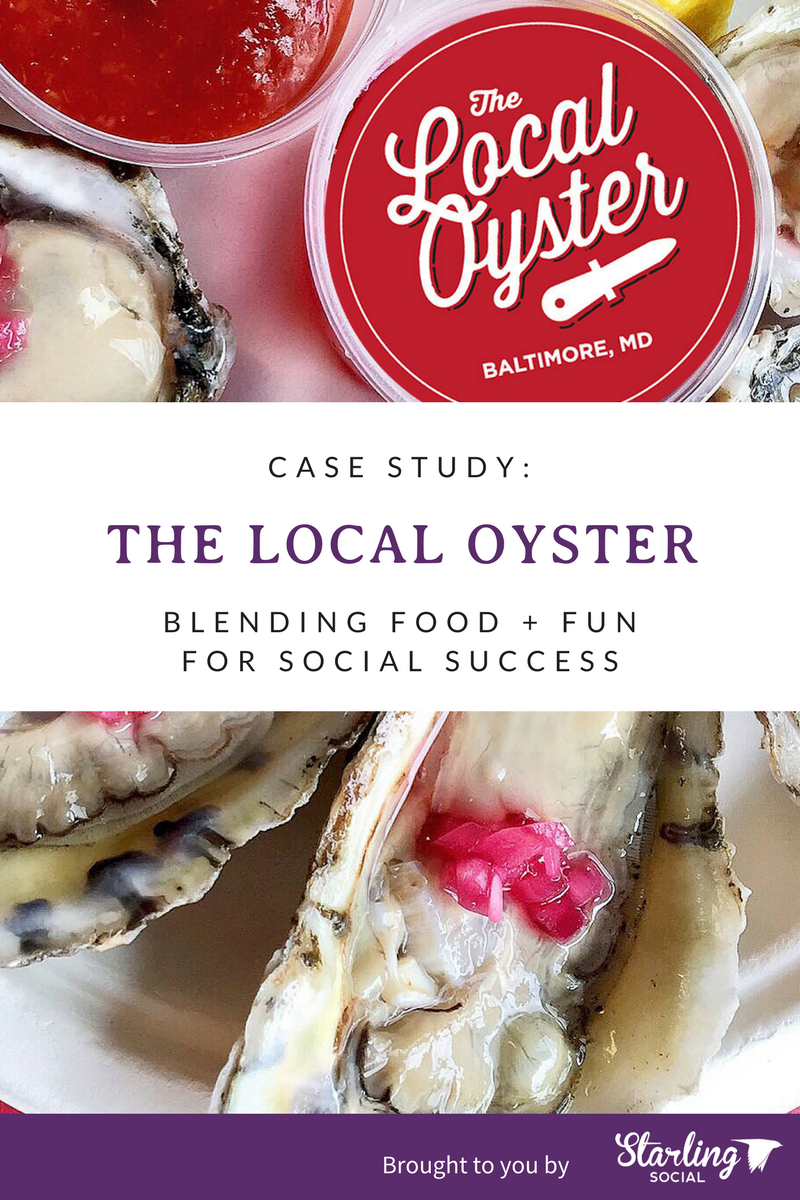
The Challenge
The biggest challenge was raising awareness. “There are several brands that are immediately associated with Baltimore (Natty Boh, UTZ, Berger Cookies, Old Bay, etc) and my hope was that over time The Local Oyster would be one of them” Nick states.
He started The Local Oyster five years ago as a side project to help pay the bills, with the intention of it eventually becoming a full-time business. He began by using a “guerilla marketing” campaign where he plastered stickers featuring The Local Oyster logo all over Baltimore, but without any previous digital marketing experience, it was a challenge to determine the best social networks to use to promote the brand.
“I had tried but never really understood Facebook, and I had never even seen Instagram until someone told me I had to use it for my business,” says Nick. “I originally used Facebook and Instagram to let the few followers I had know where I was going to be set up shucking oysters…”

The Solution
“I’ve always considered myself a bit goofy, so that’s what I do,” says Nick. “I take pictures of stupid stuff and food and post it on Instagram.
Instead of trying to game Instagram’s algorithm or spending time determining the best hashtags to reach the widest possible audience, Nick and his team have instead chosen to focus on being as authentically themselves as possible.
Where many business owners would shy away from handling the social media for their business, Nick decided to play on his strengths and use his creativity and outgoing, goofy personality to create interesting, funny, and timely content for The Local Oyster’s social media profiles that got followers as excited about the restaurant as he is.

Nick regularly dresses up in silly costumes, takes videos of himself promoting local events and collaborations with other restaurants, businesses, and nonprofits, and uses this content to showcase just as much of The Local Oyster’s brand as the delicious, local food they serve.
By documenting themselves having fun at events, posting silly group photos, videos, and by not taking themselves too seriously Nick and his team have cultivated an engaged and excited audience of people who take their restaurant (and their food!) very, very seriously.
In addition to growing a loyal online following, The Local Oyster is now recognized as one of the best oyster bars in Baltimore.Your Takeaway
The fear of “looking silly” often trumps people’s ability to create interesting and unique content for their brand, which puts them at a disadvantage.
This is especially true for many restaurants and other B2C businesses, many of whom are apprehensive about appearing on their Instagram feeds, participating in Facebook Live videos at events, and partnering with organizations like nonprofits which may not be directly “on brand” but which convey their personal and brand values.
However, as we always tell our clients: social networks, algorithms, and hashtags change, but the thing that will keep your customers buying from your brand over and over again is your brand values and personality.

Or, as Nick puts it:
“My ultimate goal with social media is to make the viewer smile a bit or even laugh every once in a while. Most restaurants post beautifully staged pictures of fancy food and are so serious. Just like me and The Local Oyster, I want our social media presence to be fun and engaging, and not so fucking fancy.”
So the next time you feel apprehensive about showing your face on your business’ social media feeds, or balk at an employee’s suggestion to shoot a quick video to promote a special or unique service, be default yes. Don’t take yourself so seriously and have some fun with your brand; your business, and your customers, will appreciate it.
Big thanks to Jen Whalen and Nick Schauman from The Local Oyster for the laughs and memories we shared in Caye Caulker, and for taking the time to answer our case study questions.
Do you need help building an online presence for your brand that's as fun and exciting as The Local Oyster's? Drop us a line and let us know how we can help; we're always looking for innovative businesses to work with. In the meantime get to know us on Facebook, Twitter, Instagram, or on LinkedIn - we can't wait to meet you.
Your Definitive Guide to Writing Awesome Email Subject Lines
- by Alyson Shane
First impressions matter.
This is especially true when it comes to email subject lines. A well-written subject line will inspire your readers to not just open your email newsletter, but also to click through and read more.
However, if your emails are lacklustre then all they'll convey to your readers is that your content isn't worth their time. That sucks - not just for you, but for your reader!
So today let's stop the spread of bad email subject lines, and turn those so-so subject lines into subject lines with pizzaz (aka: earn high drive Open Rates and drive those click-throughs that are an integral part of our inbound marketing strategy.)
Let's dive right in:
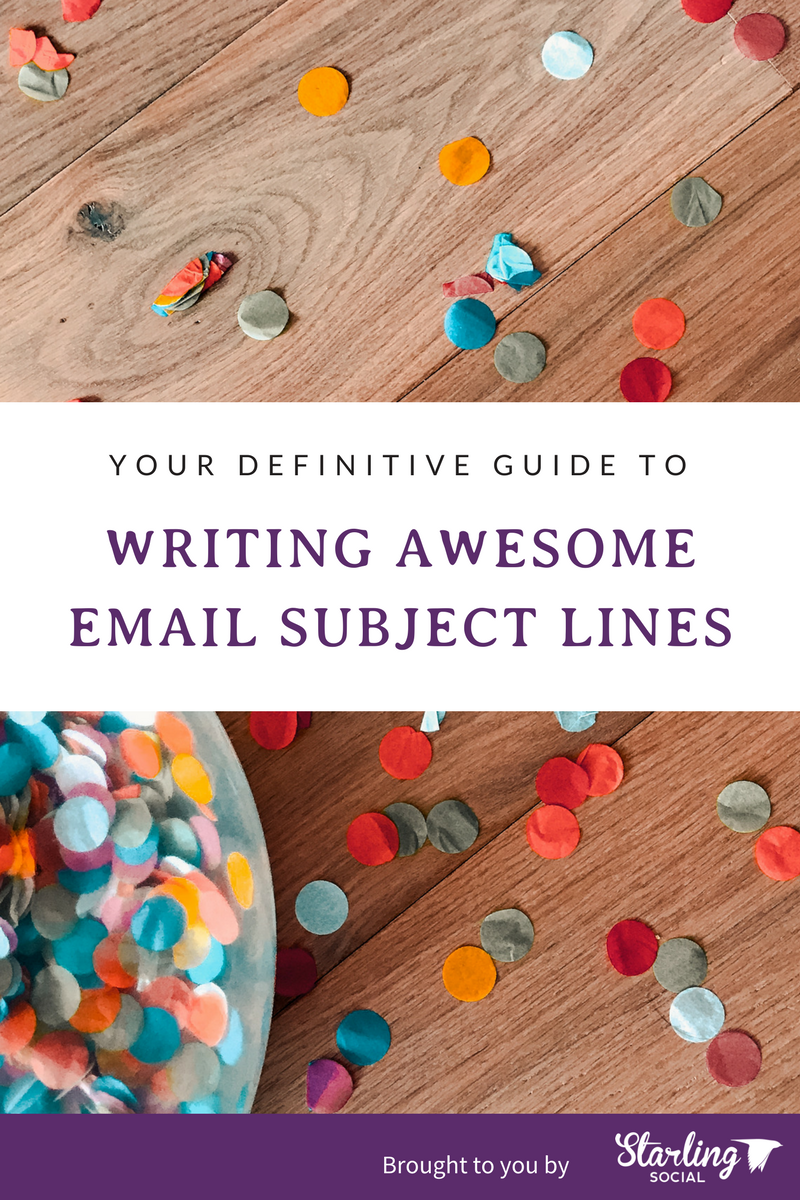
Why Do Subject Lines Matter?
To understand why subject lines are so important, think about how you feel when you receive an email: what's the first thing you see?
The subject line; and whatever that subject line says determines how excited you are to open the email, right? Right - and this applies to everyone else out there, too: it's often the determining factor in whether or not a reader is excited to open your email.
In fact, Convince & Convert concluded that 35% of marketing emails are opened based on the subject line alone. This means that your subject lines are your first (and best) tactic to get readers to engage with your content.
What Makes a "Good" Email Subject Line Good?
When it comes to creating email subject lines that drive action it's imperative that we tap into a few areas that resonate with our readers. Those include:
Stating the Benefit
How will your reader benefit from opening your email? Are you offering them a great deal; providing them with info that will move their business forward; or teaching them something new?
By telling your readers what they can expect inside your email you can encourage them to open it right away. Some examples of headlines that state the benefit of the email include:
- Become a better public speaker (benefit: becoming a stronger public speaker.)
- PowerPoint hacks for your next presentation (benefit: PPT tips.)
- Reduce meeting length with this simple trick (benefit: make meetings shorter.)
Getting Emotional
Think of your subject like an article headline: would you click on an article with your email subject line? If not, it may be because your subject line isn't emotional enough.
When we say "get emotional" we don't mean throw a tantrum like Kim K's kid at fashion week. We mean using words that appeal to a reader's emotions and which incentivize them to take action based on how they feel. These can include:
- Happiness. Use your subject lines to make people feel happy, or joyous about something.
- Curiosity. Pique readers' curiosity with an enticing email subject line.
- Urgency. What can you say that will make your reader want to take action right now?
- Excitement. How can you make your readers feel excited to read your email?
This may sound all well and good, but what are some rhetorical tactics you can use to actually convey those emotions in your subject line? Let's look at a few ways:
Subject Lines That Inspire: Excitement
Nobody wants to open a boring email, and if your subject doesn't let your readers know that something exciting is inside then your email might find it's way straight to the Trash bin. Get your readers excited to discover what's inside by using these tactics:
- Use action verbs. Think back to your English class and tap into those action words! We love ThriveHive's list of powerful words for powerful email subject lines.
- Make your emails sound exclusive. Copy like "can you keep a secret" and "just for you" will make readers feel like they have the inside scoop by opening your email.
- Use powerful statistics. Use accurate but interesting or surprising statistics like "marketers who use this tactic see a 72% increase in conversions" to make readers feel excited about what's inside your email.
Subject Lines That Inspire: Curiosity
Don't over-explain in your subject line! The best subject lines are ones which leave a little to the imagination and leave readers wondering what's next. Use some of these examples to create your own:
- Start with the end. Use subject lines that ask a question, like: "how did this marketer wow CEOs at their company?"
- Start with an open-ended question. Subject lines like "what's new with us..." are perfect openers to inspire curiosity because they can only be answered by opening your email.
- Use cliffhangers. Start your subject lines with sentences that don't tell the whole story, like: "Matt used these 6 steps to increase his email open rates..."
Subject Lines That Inspire: Urgency
Urgency inspires them to take the action you want them to take right now, and is one of the oldest marketing tricks in the book. Some examples of how to use urgency in your subject lines include:
- Giving your reader a deadline. Using countdowns ("only 3 days left!") and copy that implies a limited time offer ("before time runs out," "before it's too late." etc.)
- Tap into your reader's FOMO. Fear Of Missing Out (FOMO) is a big driver, so use your subject lines to imply that they'll miss out on something amazing if they don't take action.
Subject Lines That Inspire: Happiness
Making your readers feel happy or joyful is one of the best ways to make your emails memorable and to inspire them to take the action you want. By making your readers feel good you're helping them associate those feelings with your brand, which can yield real long-term ROI.
Some ways you can craft your subject lines to inspire happiness include:
- Use humour. Making people laugh is one of the easiest ways to make them feel happy, so get creative with those opening lines!
- Don't be afraid of emojis. Many businesses avoid emojis because they worry they look "unprofessional" but they can make a big difference in earning those Email Opens.
The key to writing successful email subject lines is to write with intentionality. Determine what your email is about before you write it, which will save you time trying to determine the kind of emotion you want to evoke in your reader.
Examples of Great Subject Lines
We've put together a collection of some of our favourite email subject line collections so you can see what a killer subject line looks like. Take a look:
- 40 Great Email Subject Lines (via ThriveHive)
- 13 Insanely Clickable Email Subject Line Examples (via Sumo)
- 164 Best Email Subject Lines to Boost Your Email Open Rates (via OptinMonster)
- 16 Email Subject Lines You'll Probably Want to Click (via HubSpot)
Love what you've just read? Give us a follow on Facebook, Twitter, LinkedIn, and Instagram and sign up for our newsletter for the latest actionable digital marketing insights. If you need some hands-on help with your digital marketing strategy feel free to drop us a line, we're happy to help.
The 4 Vital Marketing Metrics That Matter to The C-Suite
- by Alyson Shane
Whether you're a FT social media manager or a part of an agency handling the social media for multiple brands, having the ability to analyze relevant data and make quick decisions is essential.
That being said, being able to report on your findings and convey the information you've gathered in a way that makes sense to your C-Suite executives can often make or break your ability to drive the changes needed to continue to increase the ROI of your efforts.
With this in mind we've compiled a list of the top marketing metrics that our C-Suite clients care about the most. Let's dive in:

Followers
Followers may be one of the first metrics that traditional marketers are quick to write off, but slow down there! The number of followers you have is important because perception matters, and a high Follower rate acts as social proof to let other users know that a brand is worth following.
How to sell it to the C-Suite
More followers = increased perceived influence.
The key to conveying the importance of Followers comes down to being able to demonstrate that your followers meet your Target Audience criteria. Being able to demonstrate that a significant portion of your Followers are people who meet a business' Ideal Customer Profile (ICP) will ensure that leadership sees the value in the communication platforms we're using.
If industry influencers (these vary depending on your industry) are following your brand on social media, use this as an opportunity to collaborate or tap into their social following in order to increase awareness about your brand.
Some actions you can take include:
- Develop Affiliate Business and Influencer lists. Use these lists to prioritize who your brand engages with on social media, and use their content as 3rd party curated content for your own timelines.
- Share interesting, educational content. Share a variety of content to help potential new followers see the value in following your brand online.
- Engage, don't just promote. Nobody wants to follow a brand that looks self-interested, so take time to quote tweets, respond to comments, and re-share interesting, industry-specific information whenever possible.
Engagement
Monitoring how often followers are liking, sharing, re-sharing, and commenting on a brand's social media content is one of the easiest ways to tell if the content you're sharing is resonating with your audience.
How to sell it to the C-Suite
Engagement = Reach = Followers = Leads / Conversions
One universal across all social media platforms is that their algorithms prioritize engagement above all else. This means that the more engagement your posts have, the higher organic (unpaid) reach your social content will have.
If your ultimate goal with your content is to drive conversions and new leads, then the more engaging your content is, the father it will reach.
Some actions you can take include:
- Pitch social media as a customer service opportunity. Sprout Social found that 35% of people prefer social media to any other channel for customer support, which means you can leverage these platforms as a way to keep customers happy.
- Seek out 1-1 conversations. According to Marketo, modern-day consumers look to social media as an opportunity to build relationships with brands. Give them that opportunity!
Leads Generated
Marketing and sales are intricately linked with one another, and one of the best ways to convey the value of social media and your digital marketing efforts is to link what you do to the leads generated by the brand you're working for (or with.)
Make sure to utilize tracking parameters in every URL you post so you can measure the leads generated from your paid and organic social campaigns and include your findings in your reports.
How to sell it to the C-Suite
Social campaigns = Conversions = Leads
The most important component of presenting this information isn't measuring which of your social campaigns have the highest lead conversion rate; it's understanding how many of those conversions became quality business leads that moved successfully through a brand's sales pipeline.
Some actions you can take include:
- Identifying your buyer's journey. Different social campaigns will speak to leads who are at different places along the buyer's journey, so determine how a campaign will use copy, visual assets, and even video to encourage them to take the next step.
- Test different content. Different content drives different responses, and a strong social strategy should include a variety of content combinations to avoid looking stale and continue to drive engagement.
Revenue
You must have known we'd be ending on this all-important metric.
Obviously whether a business is generating revenue will play in to whether or not they have the bandwidth, budget, and interest in social promotion, but your role as a marketer is to draw a connection between what you do and the revenue the business generates.
How to sell it to the C-Suite
Social promotion = engagement + reach = new leads / customers = revenue
Digital marketing is a game that requires long-term investment. C-suite executives who expect to see an instant increase in ROI need a reality check, because social promotion isn't just about acquiring new leads; it's also about nurturing existing relationships and converting our audience from followers to brand advocates.
Brand advocates are individuals who not only buy from the same brand on a repeat basis, but they actively engage with the business online, recommend their products and services to their friends, and colleagues, and generally report positive and trusting feelings about that brand.
Some actions you can take include:
- Don't expect the most out of every channel. Depending on your industry, some social channels are great for lead generation, while others are better for nurturing existing relationships.
- Some leads take time to convert. Most consumers (B2B and B2C) need time to familiarize themselves with a new brand before making a purchase or reaching out.
Are there any metrics that your c-suite is obsessed with? Let us know on Facebook, Twitter, LinkedIn, or on Instagram!
The 4 Key Website Marketing Metrics You Need To Track
- by Alyson Shane
One of the critical components involved in understanding how your marketing efforts are translating into real-world actions is connecting your website with your marketing campaigns.
When you understand how the actions you're taking online: organic social media engagement, sharing blog content, hosting events and webinars, and running targeted paid advertising campaigns all connect to actions visitors take (or should be taking) on your website, you can begin to understand how and why (or why not) your efforts are yielding the results you need to grow your business.
This blog post will cover some of the key marketing metrics for planning and increasing the Return on Investment (ROI) of your digital marketing efforts of through your website.
Let's get started, shall we?
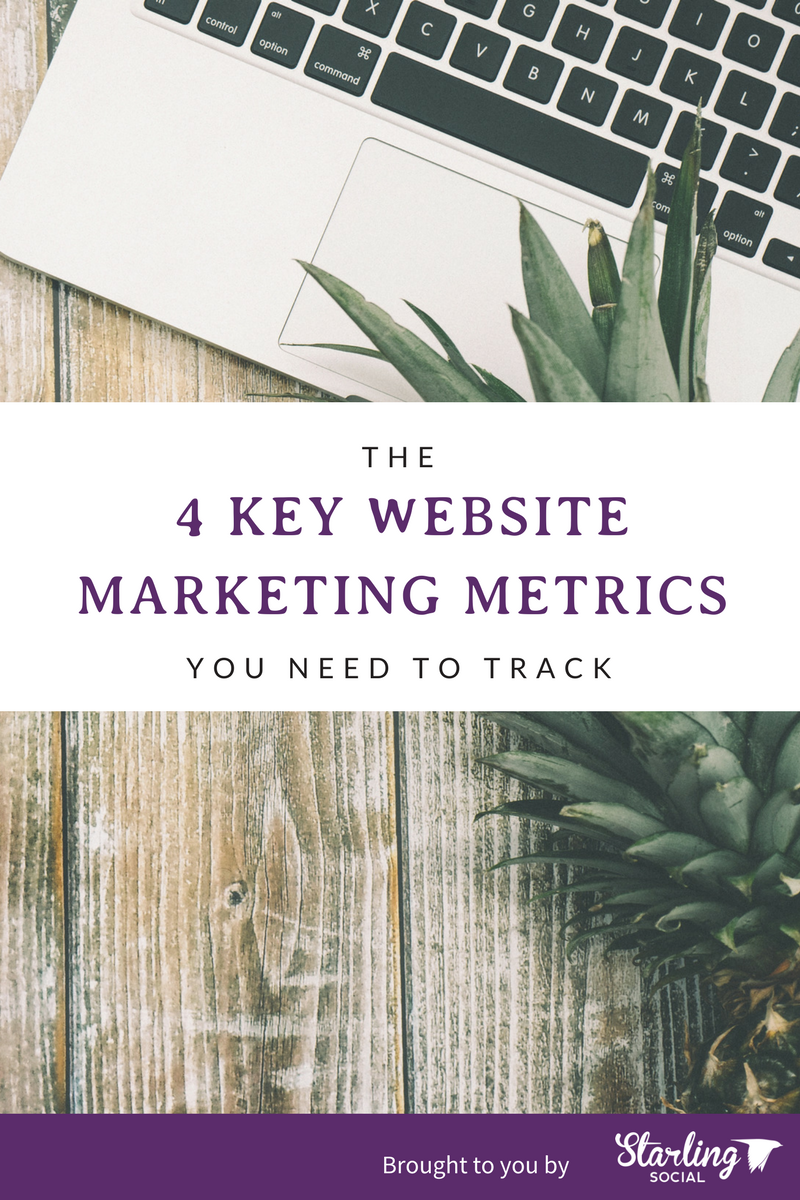
1. Website Visitors
Understanding who is arriving at your website is almost as important as what they do when they get there. Take a glance at the following areas for a deeper understanding of who's visiting your website:
Audience Analysis
Analyzing the age, gender, language, and location and comparing your findings to your Buyer Profiles or Ideal Customer Profiles (ICPs) will let you know right away if your efforts are sending the right kinds of people to your website.
For example, if your ICP for your monthly men's shaving kits are men age 20 - 45 with who live in the Baltimore, MA area and make more than $45,000/yr, and your web traffic is comprised primarily of men age 18 - 24 who live in the Baltimore, MA area and make less than $30,000/yr, then you need to rethink your messaging and paid ad targeting.
Additionally, if the majority of your web traffic is coming from a different target location then you may need to re-think your targeting parameters and re-evaluate your hashtag strategy.
Devices, Tech + Interests
Understanding the tech your visitors are using to view your site plays an important role in how long they stay on your page. According to HubSpot, Google drives 95% of all paid search ad clicks on mobile, so make sure that if the majority of your visitors are looking at your website on their mobile devices that your site ie mobile-friendly and loads quickly.
If not, your Bounce Rate (people who leave your website after viewing only one page) may suffer as a result.
Interests can also be instrumental in understanding if you're targeting the right people with your marketing marketing material. For example, if your web traffic is the right age group but isn't converting, check to see if the "Interests" of the users visiting your website align with your products and services; if not, it's time to revisit your ICP and hone your messaging and targeting.
2. Site Content
Real talk: if the content on your website is lackluster then your visitors aren't going to stick around to see what else you have to say.
Page Metrics show you the Most Viewed Pages, Average Time Spent on each page, and the Least Viewed Pages. By paying attention to these data points over time you can see how deep visitors go (or don't go) into your website once they've arrived, and track to see what they do along the way.
Other metrics to track include:
- Session Duration
- Bounce Rate
- Exit Rate
- Exit Pages
Review the pages with the highest Bounce Rate and lowest Session Duration, as well as the Exit Rate and Exit Pages to understand why those pages are leading visitors to bounce away. Are they loading too slowly? Is the page layout confusing or broken? Is the copy lacking in valuable content?
By regularly assessing how these pages are performing and strengthening the weak spots on your website you can test and fix them on an ongoing basis to keep your visitors engaged and active on your site.
3. Acquisition
How are people finding your website? Once you understand where your web traffic is coming from you can develop campaigns and strategies to capitalize on those traffic sources. Some key areas to monitor include:
- Channels. Show you the sessions brought by social media, search, email, and more.
- Source/Medium. Similar to the above, but is specific to the service or website.
- Referrals. Where your website was referred from somewhere else online.
If you're running several paid campaigns across multiple digital channels, compare these findings against your campaigns in order to determine where to focus the majority of your digital marketing advertising budget.
4. Conversions
With all these metrics to track it may seem like we're getting away from matters: website conversions, but that's not the case.
In fact, by developing a comprehensive digital marketing strategy your business is more likely to convert website visitors into customers, and the best way to track your efforts is to set up Conversion Goals.
Conversion Goals are exactly what they sound like: they're the final action you want to visitor to take after arriving on a specific page on your website. Conversion goals can include:
- Subscribing to your newsletter
- Registering for an event or webinar
- Filling out a contact form
- Making a purchase/completing checkout
By attributing a value to each of these conversions (transaction, future lead, etc.) you can determine the "end goal" of your website and track how visitors are responding to your efforts. As you continue to track, test, hone, and continually work on optimizing your website to convert you'll begin to see increases in your goal conversions.
What's Next?
By continually honing your website and tracking key metrics you'll soon have a well-developed understanding of how, where, and why your website visitors are finding your business, and the steps you can take to convert them once they arrive on your site.
The first step in this process is a thorough website content and digital marketing assessment. If you're not sure how to perform one for yourself, get in touch and let our team of digital marketing experts help your brand sing.
Love what you've just read? Give us a follow on Facebook, Twitter, LinkedIn, and Instagram and sign up for our newsletter for the latest actionable digital marketing insights.
Lessons From Netflix's Super Bowl Ad for The Cloverfield Paradox
- by Alyson Shane
Even if you don't watch football, the results of last night's Super Bowl LII should have left you with your jaw on the floor.
No - we're not talking about how the Eagles pulled ahead at the last minute thanks to the touchdown pass caught by QB Nick Foles; we're talking about Netflix's surprise ad and movie release for The Cloverfield Paradox.
For those of you who may have missed it, Netflix sprung a trick play on audiences by investing in a highly-coveted Super Bowl ad for the latest installment in J.J. Abrams' sci-fi franchise Cloverfield: The Cloverfield Paradox.
The ad, which aired during the second quarter, ends with text which reads: "coming very soon" which was followed by an announcement from Netflix stating that they would begin streaming the film online immediately after the game.
Naturally people began freaking out about it online, hailing it as one of the most innovative ways to market a box-office film ever. Netflix's edgy, innovative strategy upended traditional assumptions about how movie advertising is done, and it's likely that things will never be the same.
Even if you're not in the business of making movies (also called "show business") there's a lot brands from other industries can learn from Netflix's groundbreaking move.
Let's explore:

Experiment With Your Approach
We all know that buying a Super Bowl ad is one of the most effective (and expensive) ways to showcase your brand, product, or service to a captive audience of millions. In fact, it's not uncommon for movie studios to drop ads for upcoming theatrical releases during the Super Bowl.
What makes Netflix's approach different is that they barely gave their audience time to react to the ad before the movie started streaming. By breaking with the tradition of releasing teaser trailers, real-world ads, multiple full-length ads, and other traditional marketing tactics, Netflix broke the mold on traditional movie and TV advertising and gave audiences exactly what they wanted within hours of showing it to them.
Netflix took advantage of the energy, excitement, and captive audience generated by the Super Bowl and channeled as much of that engaged audience as possible into their digital streaming platform as soon as the game was over.
Your Takeaway
Don't be afraid to surprise your audience. We love the unexpected, especially when it comes to advertising, and breaking with tradition and experimenting on an ongoing basis will not only help you develop a better understanding of what your customers or clients behave, but you'll keep them on their toes which will keep them as engaged with your brand as possible.
Experiment With Audience Conversion Tactics
"You can't advertise during the Super Bowl and expect people to watch your movie right after!"
What do you think the odds are that someone, at some point throughout planning this campaign, said this? Pretty likely, and it's because what Netflix did flew in the face of traditional audience conversion tactics.
Think about it this way: Netflix managed to draw in an audience of viewers tuned into an unrelated live event and converted them to their digital streaming platform immediately after the event ended.
This is a huge risk for advertisers, as we know that it can be hard to replicate marketing ROI success across different audience types (Facebook audiences react to different content than LinkedIn audiences, for example) but Netflix wasn't afraid to experiment with a new approach which encouraged audiences to turn off one streaming service (their digital package or cable provider) and turn to another - their own.
Your Takeaway
If you know you have a captive audience on another platform or digital medium and you need to find ways of converting them, invest in ads specifically for the purpose of funneling them to your site or platform.
Don't be afraid to encourage cross-platform conversions! Pay attention to when audiences on other platforms are most engaged, or are likely to be online, and direct your advertising dollars into ads that run during those peak times in order to capitalize on the existing, engaged audience like Netflix did.
Don't be Afraid to Experiment. Period.
This isn't the first time that Netflix has shaken up traditional TV and movie advertising tactics.
Back in 2013, they shocked audiences by dropping all 13 episodes of House of Cards at once, effectively ushering in the age of binge-watching and changing how most people consume media.
At the time it was considered a groundbreaking move, but several years on the practice has become so commonplace that many of us allocate weekends to "binge" one season of a show or another. This shows us that taking risks and changing up traditional models can not only result in ongoing publicity and media - something every brand wants - but can fundamentally shape how your clients and customers interact with your products or services on an ongoing basis.
Your Takeaway
TRY NEW TACTICS.
If there's anything that this article and Netflix's strategies should tell you, it's that being bold and trying new methods of advertising, sharing information, and audience conversions is the way of the future.
Most brands are finding it harder and harder to stand out online, and the only way to create a viral hit à la Netflix is to step outside of your comfort zone and spend some time experimenting with new and innovative ways of reaching your audience.
With this new Super Bowl ad and immediate release Netflix has once again shown a determination to challenge the assumptions of traditional advertising, and we can't wait to see where they go next.
What's your reaction to Netflix's ad for The Cloverfield Paradox?
Let us know by dropping us a line on Facebook, Twitter, LinkedIn, or leave us a comment on Instagram!
4 Social Media "Bad Habits" to Kick in 2018
- by Alyson Shane
The start of a new year is an opportunity to consider what we want to spend the next 365 days doing with our time, and provides an important benchmark by which we can measure our progress.
We say "this year I'm going to get in shape" or "this year I'm going to eat fewer pancakes" (yeah, right). It's also an opportunity to assess how we've done over the past year, and to start setting goals to make positive changes in the year ahead.
Luckily, there's no better time to start making positive changes than right now, so here are a few "bad habits" that you may be guilty of making on social media over the past year, as well as some handy suggestions on you can improve on them in 2018:
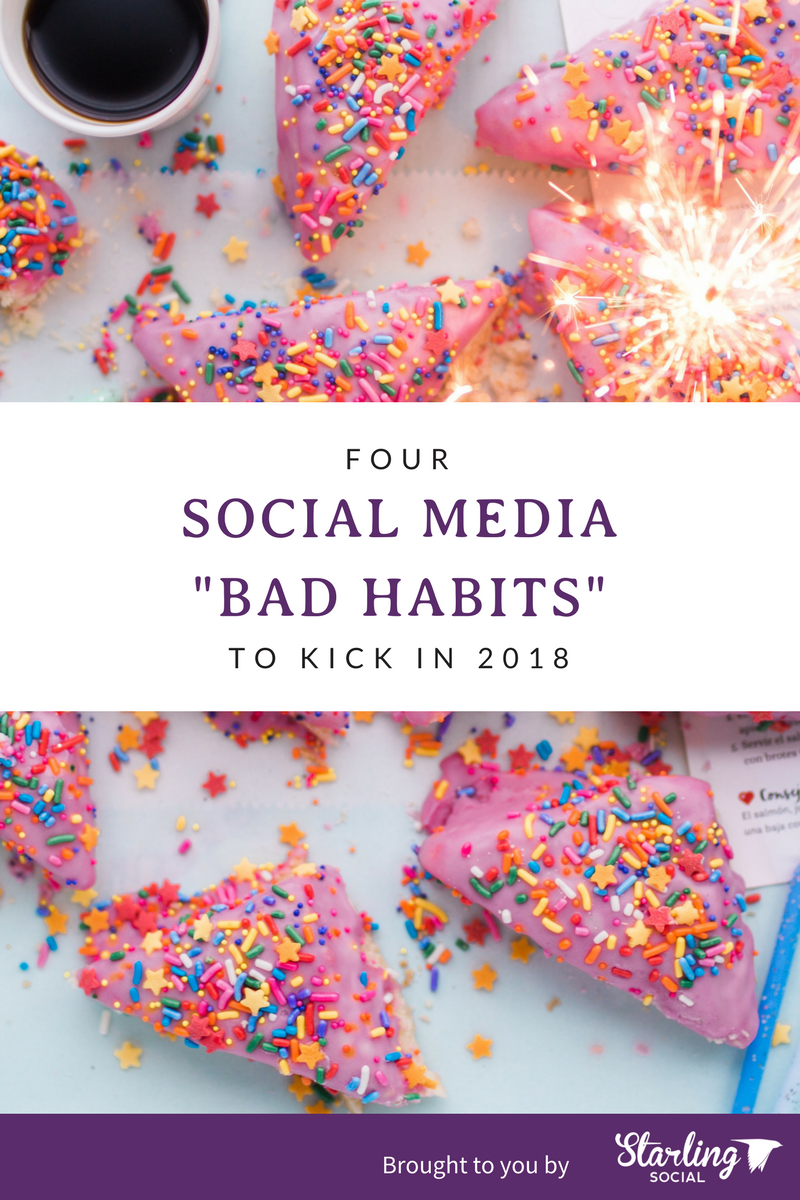
Being "All Business" Online
One of the biggest challenges facing the modern business landscape is how social media saturation forces brands to be more personal, quirky, and entertaining to their potential customers than ever before.
These days it's not enough to have a great logo and a website that converts; your brand has to have a strong set of values, an identifiable voice and tone appropriate for each social network, and the confidence to crack a joke once or be clever in a post or reply. Having a strong brand identity is essential in a world where most markets are over-crowded at best, and by being bold and confident in the content you share helps you stand out from the pack.
Your social media profiles are where your customers get to know you best, so use them as opportunities to show off your personality while still maintaining a professional and courteous approach.
Steps You Can Take
There are a few ways you can infuse your social profiles with a little extra personality from time to time. Some things you can try right now include:
Sharing curated content
Bonus points if it's from a thought leader in your industry, an industry partner, or a fellow colleague (assuming the content is appropriate.) Sharing curated content says "we liked this and wanted to share it with you. Since we both like this content, we have something in common."
Piggybacking on popular hashtags
Hashtags are essential to growing your audience on Twitter and Instagram and we love using popular hashtags like #WisdomWednesdays on Twitter to share insights from our clients' industries to their followers and help them reach a broader audience using the same hashtag.
Embracing memes
We're not suggesting that you start posting photos of Scumbag Steve every time you get a customer complaint, but memes are an easy way to add some "cool" points to your brand, and tools like memegenerator allow you to make your own, industry-specific jokes you can share.*
* If you make any silly industry memes, please tweet them at us.
Selling on Your Personal Facebook Profile
Unless you keep your friends in the dark about what you do, it's likely that you've shared updates and posts related to your business on your Facebook Timeline sometime within the past 365 days - and that's okay, you're a business owner and you need to hustle to keep the lights on.
What you should aim to nix in the new year is promoting your business directly through your Personal Profile, and working to grow your Business Page Audience instead of posting about promotions through your personal profile.
By focusing your efforts on growing your Business Page to a wider target audience, you increase the likelihood that you'll attract customers to your Page who have never interacted with your brand before, and who probably don't know you personally.
Steps You Can Take
The best way to promote your business on your own time is to re-share content from your Business Page through your personal profile (by clicking "Share > Share on Your Timeline" on the post) and to use your Business Page to find new customers beyond your personal Facebook connections (friends and family.)
Here's what you can do:
- Set up a Facebook Business Page (if you don't have one already)
- Fill in as much detail about your business as possible.
- Invite people to 'Like' your page.
- Post to your Facebook Page often, and measure the results.
- Use existing Customer Lists (if available) to create Facebook Custom Audiences.
- Use those audiences to create Facebook Lookalike Audiences.
- Invest in some Facebook Ads to expand your audience beyond just your family and friends.
- Re-target previous audiences, test, and keep expanding!
(If this sounds like way too much work just give us a shout. We're happy to handle this for you.)
Not Engaging With Your Followers
Real talk: all the content scheduling tools in the world won't help you build an audience who actually care about what you have to say, online or otherwise.
We believe that the best way to get others to care about you is to care about them first, and that means being engaged and responsive whenever someone mentions your brand. If someone has taken the time to leave you a comment, post a review, or re-share your content the easiest way to show them that you appreciate them is to say so.
Not responding tells your customers that you don't care about them, and that you aren't paying attention to them when they try to talk to you, address a concern, or file a complaint. It may feel tempting to 'hide', 'delete' or just ignore any negative commentary but think about it this way: how would you feel if a brand you used to love deleted your comment instead of addressing your concern?
So be thankful for it all: the bad, the good, and make sure to let your audience know how much you appreciate them.
Steps You Can Take
Showing your audience that you care about them not only builds brand loyalty with your existing customers, but it also shows any newcomers that they can always expect timely, helpful, and positive interactions with you online.
Here's a quick breakdown of ways you can show your audience that you're plugged in and listening to what they have to say:
- Respond to Tweets, Facebook and Instagram comments as soon as possible.
- Check your Twitter and Facebook DMs daily.
- Check your Instagram Story Mentions and Messages daily.
- Thank critics for their feedback and never lose your cool.
- Be genuine in your replies and say "thank you" a lot.
- Re-share user generated content related to your brand, like Instagram photos and Tweets.
Not Paying It Forward
The best thing you can do for someone else's business is buy from them. If you can't buy from them, re-share their content, give kudos or congratulations, and take time this year to lift up the businesses in your industry and community through your own social media channels.
Lots of businesses are wary of spending time promoting other businesses or people - we often get asked "what's the benefit of promoting other businesses?" and our answer is always the same: people want to do business with people they like, and the easiest way to be liked is to support others.
Steps You Can Take
By paying it forward with your social media you're directly contributing to promoting a business ecosystem which benefits both your business and those around you. You get to be a good person while also building good will within your industry and community - it's a pretty great deal, if you ask us. Here are a few easy ways to get started:
Showcase your values
Is you're an SME then you probably rely on your connection to your local community at least to some degree in order to keep your business running. With this in mind, re-sharing content that showcases your company's values can go a long way towards helping grow both your community and your customer base.
For example, if your office is full of animal lovers consider periodically sharing news from your local humane society.
Give shout-outs
Identify businesses in your industry and community that you can support through your online presence, such as other members of your local Chamber of Commerce, nonprofit member associations, and past and present clients (ask permission first)
For example, if your business is sponsoring an event, take the time to give a shout-out to the other sponsors who also made the event a possibility.
That's a wrap on 2017!
Do you have any big social media habits you plan to kick in the coming year? Let us know on Facebook, Twitter, or drop us a line on LinkedIn!
Oh, and PS: if you're looking for a team of creative, data-driven writers and digital marketers to take your brand to the next level in 2018 we're now accepting new clients. So y'know, give us a shout.
Happy New Year everyone!

7 Not-Just-Marketing Books to Read This Holiday Season
- by Alyson Shane
It's almost the holiday season (yahoo!) and while the the time away from the office may provide an opportunity to overeat (hi, carbs), toast to friends, family, and loved ones, and catch up on some much-needed rest, it's also a great opportunity to sink your teeth into a good book.
In our case, we love reading books about marketing from thought leaders in our industry. Reading their books provides us with valuable sources of inspiration and knowledge, helps us better understand the minds behind some of the biggest successes in our field, and often provide us with answers and lessons that we can apply to solving future challenges for our clients.
That being said, there are often lessons to be learned in books that aren't specifically about our industry, as well, which is why our holiday roundup includes some marketing and business classics, as well as a few other interesting reads thrown in for good measure.
So if you're thinking of putting aside some time to get a little learning in while you relax over the holidays, consider curling up with one of these entertaining, info-packed, thought-provoking reads:

1. How to Win Friends and Influence People
How to Win Friends and Influence People by Dale Carnegie is one of the best-selling self-help books ever written, and it played a pivotal role in how we think about how we represent our clients online.
When we act on our client's behalf, by posting to their social media, for example, we consider every engagement to be an opportunity to further develop our relationship with that individual. By using techniques outlined in the book (the TL;DR of which is essentially "be interested in people, listen, ask engaged questions, and be polite") we work to create meaningful relationships with our client's audiences and customers by paying attention and being genuinely interested in how they're doing, not just how they're engaging with us.
2. Steve Jobs
Whether you love or hate Apple products, this biography of Steve Jobs by Walter Isaacson is a fascinating look into the passion, values, and drive behind one of the most influential figures in the modern tech world.
Steve Jobs not only played a major role in revolutionizing desktop and mobile technology, but he created a fan base who have an almost cult-like obsession with his products, and this deep dive into the mind of the tech giant is a must-read for any marketer or entrepreneur.
3. Blue Ocean Strategy
Starting a new business can be daunting for any entrepreneur, especially if you're starting a business in a space that's already saturated with similar businesses (like *ahem* digital marketing.) Luckily, in 2005 professors W. Chan Kim and Renée Mauborgne and their book Blue Ocean Shift provided an innovative way of looking at how companies can create "blue oceans" of uncontested market space (compared to "red oceans" already full of competitors and their blood - yikes.)
While the original is a great read, the recently released an updated version of the original which includes updated case studies and examples, chapter expansions and additions, and a new preface by the authors (with the great title "Help! My Ocean is Turning Red") for businesses who may now be feeling the effects of increasing competitiveness in their market.
4. The Tipping Point: How Little Things Can Make a Big Difference
Malcom Gladwell is a whip-smart thinker who wrote one of our favorite books about language (The Stuff of Thought) and The Tipping Point is one of our favorite books about how trends catch on in popular culture.
Gladwell bases his analyses on several factors, including the "stickiness factor" which makes a message memorable (our pals in the startup world are probably familiar with this term), the power of context, and how external factors influence widespread human behavior. He also describes what he calls the "Law of the Few" and how 80% of change is created, discovered, and shared by three types of people: Connectors, Salesmen, and Mavens.
(If you read this one, or have read it, tweet at us and let us know which one you think you are!)
5. The Book of Business Awesome/Un-Awesome
Despite the super-cheesy catchphrase ("UnAwesome is UnAcceptable", har har) Scott Stratten's book is a must-read for any marketer looking to make a significant impact in today's digital landscape and provides meaningful examples of the good, bad, and (ahem) UnAwesome. Even though it's a little junior - it's meant for people who don't already live their lives completely immersed in social media - it's still a valuable reminder of some of the most important aspects of navigating the digital landscape.
One of the biggest takeaways from the book is this: whatever you did before social media is only going to be amplified by your digital presence. If you're new to the world of personal branding, social media, and digital marketing, or just looking for an entertaining and clever refresher on the basics, then this book should be the first one on your holiday reading list.
6. Writing on the Wall
If you're looking for an in-depth read about how humans communicate then we recommend Tom Standage's Writing on the Wall, which offers a historical perspective on where we've come from and where we are when it comes to sharing information.
Starting with the Roman Empire and erasable wax tablets used an informal messaging system (told you he started early), moving through the Dark Ages where most literary men lived in monasteries and information was scarce, through to Gutenburg and the printing press and into modern-day communications methods including TV, radio, and - of course - social media, Standage's book is a great read for anyone interested in the story of how our species has recorded, stored, and shared what we know.
7. The Digital Divide: Arguments for and Against Facebook, Google, Texting, and the Age of Social Networking
Did 2017 feel like a year when you couldn't hear a balanced argument? Then dive into this collection of essays and arguments from marketers, authors, and thinkers from both sides of the spectrum when it comes to the positive and negative influence of social media on our society.
Interestingly, instead of dividing the book into "pro" and "con" sections, the essays are organized by subject, so the chapters like "Social and Personal Life," "The Human (and Political) Impact," and "Learning in and out of the Classroom" feel more like discussions than arguments for and against one side or the other.
One of the most pertinent questions of our time is "is social media doing more harm than good?" and this read should provide some valuable food for thought for those holiday debates with the family luddite.
Are you reading anything interesting this season? Tweet at us or leave us a Facebook comment and give us your recommendations!
Why the FCC's Net Neutrality Rollback Matters To You
- by Alyson Shane
Yesterday on December 14, 2017 the Federal Communications Commission (FCC) of the United States voted to eliminate net neutrality rules, effectively allowing Internet Service Providers (ISPs) to become gatekeepers to content on the internet, and allowing them to legally block websites and services.
Today we want to talk to you a little bit about why this matters so much to us here at Starling Social, and why you should care, too.
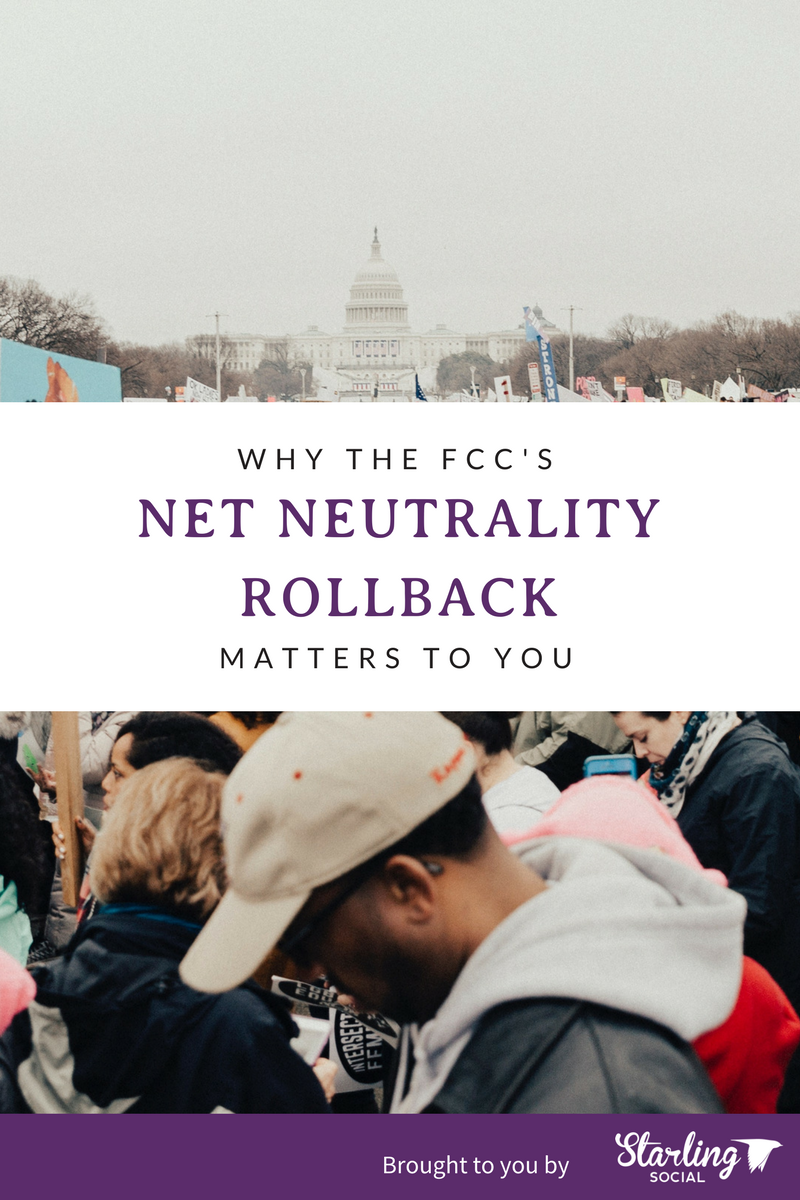
What is Net Neutrality + Why Does It Matter?
Net neutrality, also referred to as "internet freedom" is the idea that your ISPs should treat all websites the same.
This means that anyone, anywhere, can launch a business, new website, or social network and have access to the same market as big tech companies, media conglomerates, and corporations. It ensures a fair playing field for everyone.
Here's a quick summary of the top four reasons why Net Neutrality is one of the most important battles of our time:
1. Net neutrality ensures equal access to information
Access to information is a human right, not a privilege. End of story.
2. Net neutrality helps prevent unfair and discriminatory pricing practices by ISPs
Without an open internet, corporations and ISPs will control how we access information by treating internet like cable packages.
So instead of paying a monthly fee to access the entire world wide web, companies will be able to charge higher premiums for access to certain websites, meaning that people who can't afford to pay the price don't have access to the same resources, information, and audience as everyone else.
Under the new rules these companies would be able to slow down or block access to services they don't like. They could also charge higher fees to rival companies and make them pay for higher transmission feeds, or set up "fast lanes" for their preferred services.
This also means that as a business you may be subject to additional fees if you want your website to be included in specific content packages - a toll nobody should have to pay.
3. Net neutrality protects freedom of speech
Your ability to speak your mind, share your opinions, and provide feedback to private business and government is your right as a citizen, and by eliminating net neutrality rules the FCC has taken steps to effectively limit free speech online.
The internet is revolutionary because it allows everyone with an internet to create news, participate in conversations, and be an active member of their local, national, and global communities. Think of recent movements like #MeToo, the Women's March, or even the rise of alt-right conservative views.
Regardless of where your political leanings lie, it's impossible to deny that the internet has played an increasingly pivotal role in political expression and organizing, and allowing ISPs to control what users can see, do, and say online undermines this democratic right.
Are you ready for an internet that looks an awful lot like the Great Firewall of China? Because that's what's coming.
4. Net neutrality promotes innovation
If you're a business owner then the repeal of net neutrality regulations should terrify you. We cannot state this plainly enough.
By giving complete control to giant corporations the FCC has cut the legs out from underneath any up-and-coming tech startup who may otherwise have had a fighting shot in a completive, but otherwise egalitarian, online ecosystem.
Until yesterday anyone - a tech startup in India, a teenager in Ohio, or a mompreneur in Australia could start a website or e-commerce store and have the same access to market as anyone else running a digital business. Now, however, your "new" website may not be included in the latest AT&T package, which means your business may lose out before you've even begun.
For example, AT&T and Verizon are expected to be the biggest beneficiaries of the FCC repeal since they can now freely give priority to the content they provide to viewers, which will likely hurt rivals like Amazon, Sling TV, YouTube... or the next wave of tech innovators and disruptors.
What Can You Do?
The internet was built on a powerful, yet amazingly simple idea: anyone with an internet connection can have access to the entirety of the world wide web, and the internet providers don't get to control what you access, or who has access to you.
Anyone who wants to start an internet service is free to do so without paying extra fees, and users were free to choose the services that they prefer - including which social networks to frequent, news sites to read, businesses to support, and so much more.
Whether you're a Canadian pal, an American colleague, or any of our digital friends from across the globe, please join us in taking these steps to fight back against this horrific attack on our most basic rights:
- Use the American Civil Liberties Union (ACLU)'s online form to ask your Member of Congress to use the Congressional Review Act to reverse the FCC’s "hasty and misguided dismantling of net neutrality protections”.
- Sign Save The Internet's petition to put pressure on U.S. lawmakers.
- Share your thoughts on social media. Make sure to use #NetNeutrality and tag @FCC on Twitter.
- Scroll down to the bottom of this page on the Fight For the Future website and use some of their more creative visual methods to spread the word.
Tell us why net neutrality matters to you by tweeting at us or leaving a comment on our Facebook page.
Choosing The Best Facebook Custom Audience for Your Business
- by Alyson Shane
Businesses are starting to wake up to the fact that, often, organic posting and engagement just isn't driving the traffic to their Facebook pages and Instagram profiles that it once did and are turning to Facebook Ads as a cost-effective way to get in front of hundreds or even thousands of new potential customers.
Here at Starling Social we've used Facebook Ads to help our clients increase webinar registration, generate new B2B leads, drive inbound website traffic, and more. We love it because Facebook allows us to dig deep and create Custom Audiences which help us retarget people who have previously engaged with our client's business in some way. This helps us keep their advertising budget low while achieving a high return on investment (ROI) for our efforts on their behalf.
If you're new to the world of Facebook Ads, or if you're still trying to wrap your head around which types of Custom Audiences you should choose for your next Facebook Ad Campaign, then you've come to the right place.
This post is a comprehensive overview on what Facebook Custom Audiences are, and the various types you can choose from to increase brand awareness and generate new leads for your business.
Ready? Let's get started!
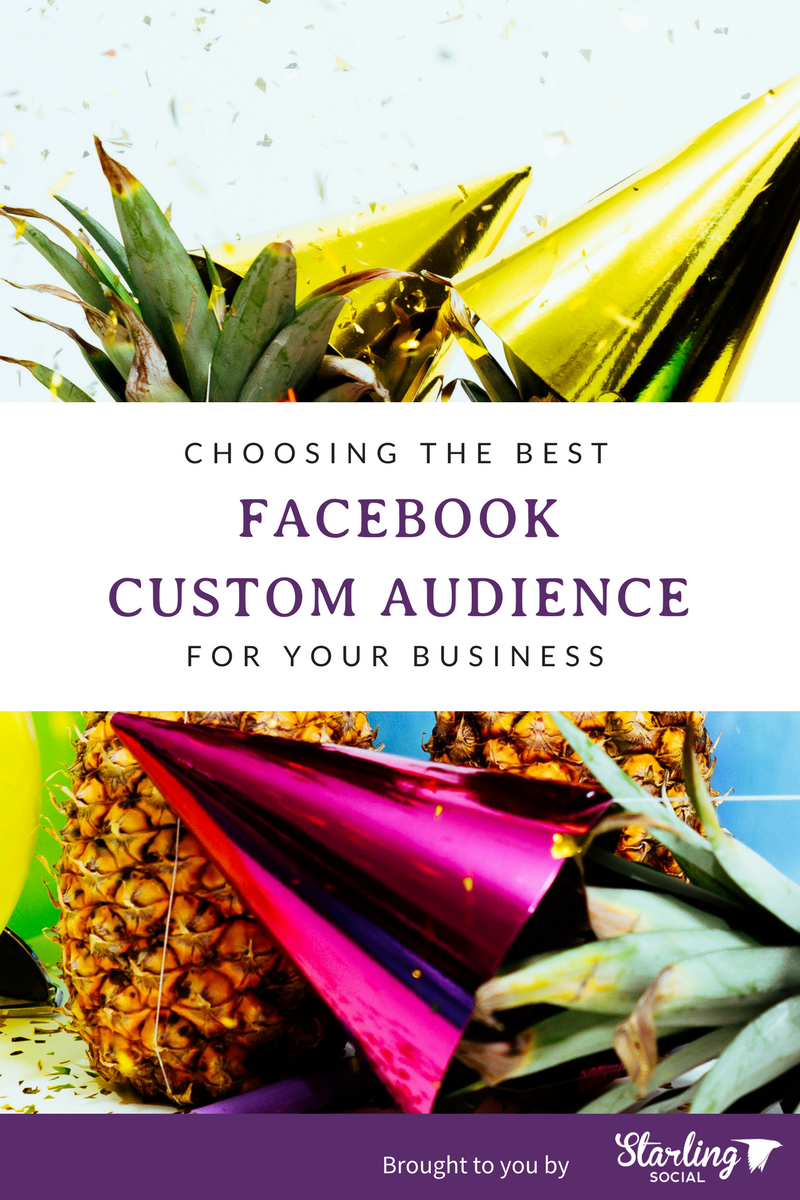
What's a Facebook Custom Audience?
Facebook Custom Audience is just that: a custom audience you can create in your Facebook Ads Manager (or Power Editor) that you can target with your ads. One of the options available is o target people who have an existing relationship with your business - say, fans of your Page - and create a campaign which retargets this audience.
Facebook gives you six options to define the existing relationship between your ad audience and your business, which are:
- Customer File. Upload a customer file (eg: list of individuals who have purchased from your e-commerce store within the past 365 days) to match your customers with people on Facebook to create an audience from the matches.
- Website Traffic. Create a list of people who visited your website or took a specific action which corresponds to your Facebook Pixel.*
- App Activity. Creates a list of people who launches your game, app, or took specific actions based on the Facebook Pixel installed in your app.
- Offline Activity. Upload a list of people who have interacted with your business in-store to create a custom audience based on phone numbers or other offline channels.
- Engagement. Creates a list of people who have recently engaged with your content on Instagram or Facebook.
* A Facebook Pixel is a code you (or your developer) installs on your website or in your app to track conversions from Facebook Ads and collect data to do stuff like build the Custom Audiences we're discussing here.
Let's sink our teeth into the different Custom Audience types available, and how they differ from each other:
Customer File Audiences
Customer File Audiences are based on a list of existing contacts available to you, such as newsletter subscribers or customers who have purchased from your e-commerce site. Syncing your customer list can be done one of two ways:
- Manually uploading your audience in a .csv or .txt file.
- Syncing your email CRM to your Facebook Ad Account.
Important: you can't mix data types, so you'll need to upload separate files for emails vs. phone numbers, for example.
We recommend giving your Custom Audience a short, easy-to-identify name which describes the specific audience, such as "Email signups" or "Past Customers."
Website Traffic Custom Audiences
If your business doesn't have a large enough database of emails, phone numbers, or Facebook User IDs to create a Custom Audience based on the steps above, you can use Website Custom Audiences to retarget visitors who have already visited your website.
This is a big boon for many businesses who are in the process of building their newsletter lists, for example, because all you need to do is make sure your Facebook pixel is installed and wait for people to visit your website. When they do, Facebook will recognize the users and automatically add them to an Audience, ready to be retargeted.
App Activity Audiences
With the explosion of mobile app popularity and Facebook mobile ads, it's no surprise that this option is becoming a popular solution for many app-based businesses.
The option allows you to target people who have previously used your app but haven't come back to use it within the last month (for example), or, you can target people who have abandoned their carts (added an item to their cart but never completed the purchase.)
There are lots of ways to retarget app audiences (currently there are 14 actions/non-actions you can target), but the most popular options are:
- Achieved a certain level in your game.
- Completed a large purchase.
- Recently opened your app.
- Recently completed a purchase.
By targeted users who have (or haven't) completed a specific action you can tailor your retargeting ads with copy and visual content which compels them to come back, such as new levels, discounts, or ads featuring new items for purchase.
Offline Activity Audiences
The Offline Activity option allows you to build Custom Audiences based on one or multiple offline events, such as Add Payment Info, Add to Wishlist, etc.
When you choose "Offline Activity" as tour Custom Audience type in Ads Manager, you can add multiple filters to refine the audiences to your specific needs. You can select multiple offline events and filters such as People Interacted Offline, Add Payment Info, Initiate Checkout, and more from the drop-down menu to restrict your list.
If you want to get super-granular, you can refine your data even further using the Custom Value or Aggregated Value options, which allows you to add conditions or values which are specific to your business goals. For example, you can add "source equals to call" to track the number of calls your business has received.
Engagement Custom Audiences
The Engagement option is especially exciting because it means you can use your ads to retarget people who have already shown an interest in your business on social media, which increases the likelihood that they will convert by 70%, according to FetchProfits.
If you click on "Engagement", a window will appear which will prompt you to define an Engagement Audience based on six different engagement types. They are:
- Video. This will target users who have watched at least three seconds of your videos on your Facebook Page or Instagram business profile.
- Lead Forms. If you already use Lead ads, you can get in front of people who have opened or completed your lead form.
- Fullscreen Experience. This option relates to the Facebook Canvas Ad option, and will retarget users who have opened your Canvas collection ads.
- Facebook Page. This is our favorite because it allows you to retarget anyone who has interacted with or visited you Facebook Page.
- Instagram Business Profile. This is similar to the Facebook Page option, but retargets to people who have interacted with your Instagram business profile.
- Event. Event retargeting is the latest addition to the Facebook Engaged Audience family, and allows you to retarget people who have RSVP'd to an event on Facebook.*
* Events must originate from your business page. Facebook won't allow you to target people who have attended similar events, or events which weren't hosted from your page.
Bonus: Custom "Lookalike Audiences"
One of our favorite ways to leverage the power of Facebook Custom Audiences is to create custom lookalike audiences. These audiences are exactly what they sound like: audiences of hundreds or thousands of people who don't know about your brand yet, but are likely to become your customers.
Lookalike audiences can be created from:
- Email Lists
- Current or Past Customers
- Page Fans
- Website Custom Audiences
- App Activity
- Conversion or Standard Events
- Engagement (App, Video, etc)
Want to learn more about the incredible benefits of creating and using Facebook Custom Lookalike Audiences? Stay tuned for our next post! If you're still struggling with Facebook Ads and would like some help elevating your brand and reaching new customers for your business, drop us a line, we're happy to help.
Want to engage with us in the meantime? Subscribe to our newsletter or say hi on Facebook, Twitter, LinkedIn, or Instagram.
SEO Research Tips for Building Your B2B Content
- by Alyson Shane
The most compelling business websites are informational, engaging, and accessible, but it’s not enough to have great content; your website also needs to be optimized to rank well in search engines in order to help prospects and readers find your content.
With this in mind, building a content marketing strategy for your business which includes a strong Search Engine Optimization (SEO) plan is necessary in an area when content is widely available, and the market is more competitive than ever, with 81% of B2B Decision Makers reporting that they conduct research on a company’s products and services before scheduling a vendor meeting. This means that your your website copy needs to be consistent in voice and tone, as well as optimized for SEO.
For content creators in B2B organizations, nailing down the phrases that prospects are plugging into search engines can feel tough. Not only can it seem like an endless process, but some content developers may feel as though they don’t have the necessary tools or expertise to get the job done.
The good news? Content creators in B2B businesses don’t need top-notch tools or years of experience developing high-quality SEO content.
Crafting great content that is SEO-driven for potential leads doesn’t have to be a mind-numbing or frustrating process. Here are some helpful SEO research tips to save you time and convert prospects into active leads:
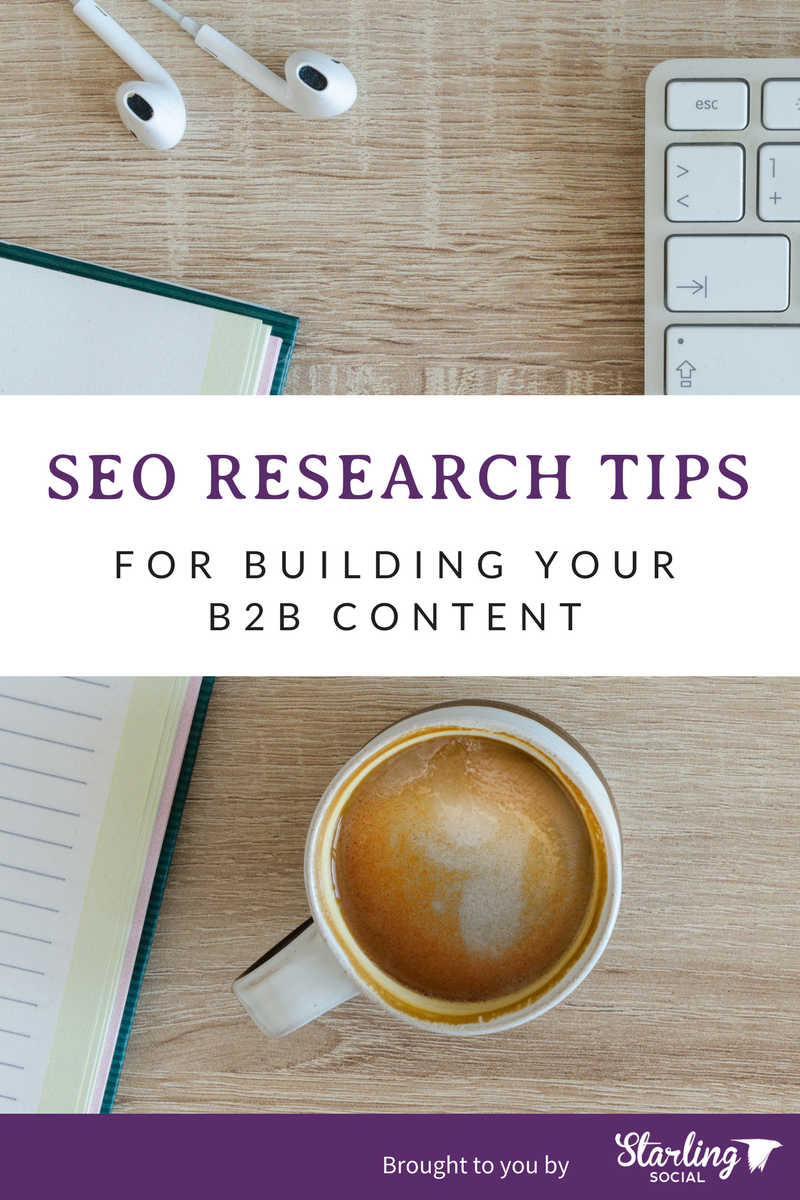
1. Copy Social Media for Keywords Straight From Your Clients
For both B2B and B2C companies, your social media platforms are a hotbed of useful information and prospect engagement. These channels are commonly used by businesses to share their experiences, thoughts, and opinions.
As a B2B company searching for keywords that your clientele relate to your business, you can use these communication platforms to your advantage by tapping into your network and creating leading questions that allow B2B prospects to share their thoughts on your brand and business.
Twitter polls, for example, allow your online community to weigh in quickly and easily on the topic you’re researching. This means that you can gauge which keywords your audience associates with your brand while allowing for further discussions you can use in other areas of your content marketing strategy.
2. Use Technology to Find Relevant Data
Tools such as Google Analytics and the associated Keyword Planner have been tools of choice for B2B businesses for years. Whether you’re a large organization or a smaller vendor or a product or service, these tools are essential for a successful foray into SEO keyword and content development.
Often used for providing cost-per-click information, average search volume data, and creating paid search campaigns, these tools provide you with measurable data so that you can see what SEO tactics are working, and which you can further refine.
This data helps B2B business’ research and discover opportunities for greater reach, relevant keywords, and move deeper into creating a unique content plan that stands out in your chosen industry.
3. Complete Relevant Keywords Searches in Incognito Mode
If you’re a marketer then you probably have an ever-expanding collection of keywords that relate to your company’s product or service.
When you enter these keywords into your chosen search engine to see where your content is on the results page, you may be surprised to find that you’re close to the top. However, this probably isn’t a coincidence: browsers can use your history or cache to impact the results to make them as relevant to your experience as possible.
In order to conquer this system, you can perform an incognito search. Input your priority or high-performing keywords and then check where your page shows up. Take a gander at the content that fills up the first 5 spots and take notes on their keyword use, spacing, and other SEO factors that may be pushing them up on the results page.
4. Writing SEO Content Based On Keywords
When it comes to actually creating the SEO content, best-in-class content is that which plays into what a prospect wants to read and the specific keywords you should be targeting. Keep your list of developed keywords closeby as you’re creating content and reference back to Google Trends every once in awhile to ensure that your topics and keywords are relevant.
Get ready to gain traffic, earn prospects, and close more B2B deals with content that is SEO-driven and ready to perform. Have you used any of these tools to up your SEO game lately? Tweet at us and let us know!
Want more insight and tools to help your brand stand out online? Download our free ebook Get Social! Content Marketing for You & Your Brand now.

